Solar Energy System Costs and Incentives - Cost Of Solar Installation
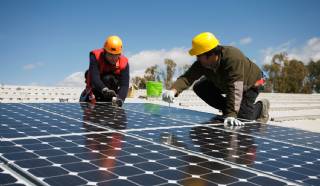
Cost depends on a number of factors (e.g. roof complexity). Most residential systems in Seattle are 4 to 5 kilowatts (kW) in size with an average installed cost of $5,000–$7,000 per kW for a total investment of $20,000 –$35,000.
Net Metering
Net metering allows solar customers to receive retail electricity rates for the electricity they generate. If you generate more electricity over a billing period than you consume, City Light will credit your electric bill for every kilowatt-hour of electricity sent back to the power grid. The credit is applied at the retail rate for power. Net metering will continue for the life of the solar electricity installation.
Federal Income Tax Credits
The federal Energy Policy Act of 2005, as amended by the Emergency Economic Stabilization Act of 2008, includes provisions for individuals and businesses to claim a 30% federal income tax credit for the cost of solar installations. Tax credits apply to systems placed in service through December 31, 2016.
Washington State Sales Tax Exemption
Until June 30, 2018, all solar electric systems less than 10 kW in size are exempt from the state sales taxes.
RESOURCE
Your Installer will provide the required forms. Exemption legislation: RCW 82.08.963
Washington Renewable Energy Production Incentive
As of August 2006, Washington State provides financial incentives for electricity generated from renewable energy resources. Eligible electricity producing renewables include solar, wind, and anaerobic digesters (converts methane gas captured from livestock manure to electricity). The state production incentive program is administered by City Light.
The incentive is based on the total number of kilowatt-hours (kWh) of electricity generated between July 1 and June 30 (or the closest regular billing cycle) of the following year. Customers with eligible generation systems that have been certified by the WA Department of Revenue (DOR), will receive a letter and application form once per year from City Light. The letter documents the system’s production based on City Light production meter readings. Once the customer approves the kWh amount and returns the signed application back to City Light, they will receive a check or bill credit for the incentive payment. Utility incentive payments are reimbursed by a credit on their state taxes.
The program authorizes utilities to pay the following for the electricity produced by PV systems:
- $0.15 /kWh for systems with no “Made in Washington” components
- $0.18 /kWh for systems with “Made in Washington” inverters
- $0.36 /kWh for systems with “Made in Washington” panels
- $0.54 /kWh for systems with “Made in Washington” panels and inverters
Incentives are capped at $5,000 per year, per customer, and expire June 30, 2020.
Green Tags or RECs
Owners of renewable energy systems own the “green tags,” also known as Renewable Energy Certificates or Credits (RECs) for an additional revenue source associated with the production of renewable energy. As demand for RECs from states, businesses, and individuals increases, we expect the value of RECs to increase as well.
Example Cost Calculations
The two examples below illustrate how different sources of revenue and savings come together and compare to initial investment in a solar electric system. They focus on the first five years after installation, as that is when most of the financial benefit will be received. However, savings on your electricity bill through net metering will continue for the lifetime of the system. Both examples below assume a 1 kW PV system that produces 1,000 kWh per year and that the system is exempt from state sales tax. The examples show the financial impact of using Washington-made solar equipment.6
Example #1
1 kW PV system (producing 1,000 kWh/year) -- non-WA equipment
PV System Installed Cost $5,000
Federal Incentive — Tax Credit, 30% of total cost $1.500
State Incentive (non-WA equipment) —15 cents /kWh, 5 year total $750
City Light Net metering — @ 8 cents /kWh, 5 year total $400
Total Incentives after 5 years $2,650
Percent of system cost recovered after 5 years 53%
Cost after 5 years of receiving incentives $2,350
Example #2
1 kW PV system (producing 1,000 kWh/year) — WA equipment
PV System Installed Cost $5,000
Federal Incentive —Tax Credit, 30% of total cost $1,500
State Incentive (WA equipment) — 54 cents /kWh, 5 year total $2,700
City Light Net metering — @ 8 cents /kWh, 5 year total $400
Total Incentives after 5 years $4,600
Percent of system cost recovered after 5 years 92%
Cost after 5 years of receiving incentives $400
Labels
1kw solar panel priceSolar panel pricesolar panel costsolar panels for salesolar panels for homesolar panels for your homesolar panel installationcost of solar panelssolar power systemsolar panel manufacturerssolar panel installation costhome solar power installationcost to install solar systeminstall solarresidential solar panels pricecost of solar panel installation for a housecost of solar installationcost of installation of solar panelsaverage cost to buy solar panelsFarming Principle: Deep Soil Preparation
Looking at GB as a three-legged stool, deep soil preparation is one of the legs. Deep soil preparation builds soil and soil structure by loosening the soil to a depth of 24 inches (60 cm). Ideal soil structure has both pore space for air and water to move freely and soil particles that hold together nicely.

Smart Home Ecosystem - Smart Home Automation - Smart Home Security - Smart Home Technology
The outer-most level corresponds to the individual devices and sensors that consumers interact with. Several candidates are vying for the role of a leader introducing smart home services to the mass market.

Solar Energy Systems - Solar Modules - Solar Electric System Design - Solar Power
The heart of a photovoltaic system is the solar module. Many photovoltaic cells are wired together by the manufacturer to produce a solar module. When installed at a site, solar modules are wired together in series to form strings. Strings of modules are connected in parallel to form an array.
Solar Energy Systems - Array Mounting Racks - Solar Ray - Solar Panel - PV Racks and Mounts
Arrays are most commonly mounted on roofs or on steel poles set in concrete. In certain applications, they may be mounted at ground level or on building walls. Solar modules can also be mounted to serve as part or all of a shade structure such as a patio cover. On roof-mounted systems, the PV array is typically mounted on fixed racks, parallel to t

Solar Energy Systems - Grounding Equipment
Grounding equipment provides a well-defined, low-resistance path from your system to the ground to protect your system from current surges from lightning strikes or equipment malfunctions. Grounding also stabilizes voltages and provides a common reference point. The grounding harness is usually located on the roof.
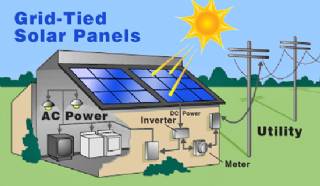
Solar Energy Systems - Solar Inverter - Solar Panel Inverter
Most grid-connected inverters can be installed outdoors, while most off-grid inverters are not weatherproof. There are essentially two types of grid-interactive inverters: those designed for use with batteries and those designed for a system without batteries.
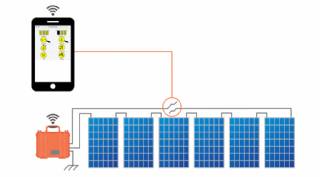
Solar Energy Systems - Solar Disconnects
Automatic and manual safety disconnects protect the wiring and components from power surges and other equipment malfunctions. They also ensure the system can be safely shut down and system components can be removed for maintenance and repair.
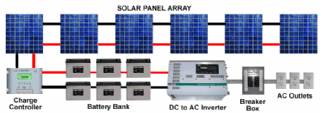
Solar Energy Systems - Solar Battery Bank
Batteries store direct current electrical energy for later use. This energy storage comes at a cost, however, since batteries reduce the efficiency and output of the PV system, typically by about 10 percent for lead-acid batteries. Batteries also increase the complexity and cost of the system.

Solar Energy Systems - Solar Charge Controller
A charge controller, sometimes referred to as a photovoltaic controller or battery charger, is only necessary in systems with battery back-up. The primary function of a charge controller is to prevent overcharging of the batteries. Most also include a lowvoltage disconnect that prevents over-discharging batteries. In addition, charge controllers pr
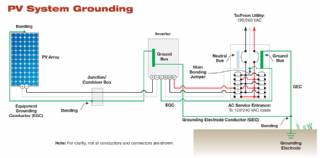
Solar Energy Systems - The NEC and PV Systems
Solar PV systems must be installed in accordance with Article 690 of the National Electric Code, which specifically deals with PV systems, as well as several other articles of the NEC that pertain to electrical systems in general. When there is a conflict between NEC 690 and any other article, NEC 690 takes precedence due to the unique nature of PV